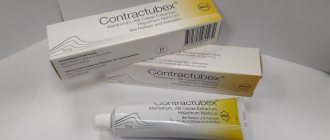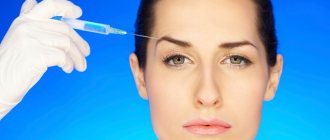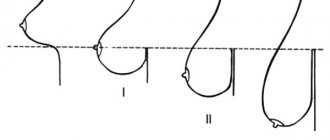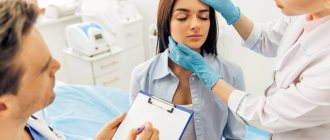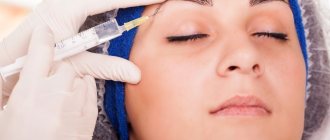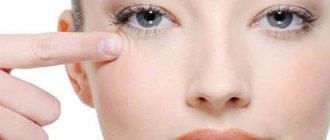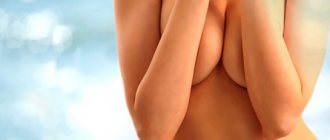Causes
The following reasons can lead to the formation of such an aesthetic defect:
- heredity;
- genetic predisposition;
- age-related changes in forehead tissue;
- age-related changes in the fatty and subdermal layers;
- relaxation of tissue connections;
- decreased muscle tone: frontal, procerus muscles, orbicularis oculi muscle;
- amyotrophy;
- muscle relaxation;
- gravitational influences on tissue;
- hyperelasticity of connective tissue (congenital);
- various injuries to the facial nerve (especially its frontal branch);
- degenerative processes in the bones of the skull;
- hyperactivity of the muscles of the forehead, bridge of the nose and orbits;
- adverse environmental influences (insolation, pollution, etc.);
- formation of wrinkles in the bridge of the nose and forehead;
- formation of pigmentation.
Cosmetological techniques for correcting drooping eyebrows in Odintsovo
Let us say right away that it is extremely rare that a patient is only concerned about drooping eyebrows; as a rule, complaints are also caused by the condition of the skin of the forehead, bridge of the nose and the periorbital area. The result of eyebrow correction will be more convincing if anti-aging procedures are carried out in parallel in these areas.
Botox injections. The best corrective procedure, which allows you to raise your eyebrows up to five millimeters, is the injection of drugs containing botulinum toxin (a toxic substance that blocks the transmission of nerve impulses). Botox for sagging eyebrows is most often used, although today there is a choice: the drugs Lantox and Dysport have a similar effect. Typically, the effect of the injections lasts up to six months, after which the drug must be administered again.
Reference. In cosmetology, botulinum toxin type A is used, which causes temporary muscle relaxation. The effect is achieved through contrast - some muscles relax, while others become toned and occupy a new location. For example, if the drug is injected into the area adjacent to the outer corner of the eye, then by relaxing the orbicularis muscle, you can raise the tip and beautifully arch the eyebrow.
Eyebrow lifting with bio-reinforcement. An injection procedure in which a reinforcing (retaining) mesh is created in the superciliary area to prevent eyebrow ptosis. For bioreinforcement, fillers containing hyaluronic acid and stimulating the production of collagen fibers are used.
Eyebrow thread lifting. If it is necessary to correct the shape and slightly raise the eyebrows, use spiral mesothreads made of absorbable material (the period of complete biodegradation is about six months). Mesothreads act similarly to compounds used for bioreinforcement and enhance the production of structural proteins. However, they also have an advantage: the thread is given a spiral shape, to which it tends to return after insertion, thereby tightening the eyebrow. For serious defects associated with drooping eyebrows, use Aptos Thread 2G - absorbable caprolactone threads (contain polylactic acid). Thanks to the notches applied to the Aptos thread, the fabrics are securely held in the right place, which means that the lasting lifting effect and beautiful shape of the eyebrows will last for at least two years.
Symptoms
The clinical picture characteristic of this cosmetic defect begins to develop gradually after 30 years. As a result of a number of reasons, partial or complete drooping of the eyebrows may occur.
The following symptoms are typical for drooping eyebrows:
- visual decrease in eyebrow level;
- reducing the distance between them;
- reducing the distance between the eyebrow and the ciliary edge of the upper eyelid;
- drooping on the upper eyelid;
- upset and tired appearance of a person;
- the face becomes dull and tired;
- a visual obstruction arises, which leads to a limitation of the field of view;
- possible severe decrease in visual acuity;
- facial asymmetry may occur;
- orbital fat may protrude;
- an abnormal eyelid fold develops;
- ptosis of the eyelid (drooping);
- tension and its elevation of the eyelid (retraction);
- the lacrimal gland descends;
- orbital fat hernia.
Rehabilitation after surgery
A forehead lift requires a mandatory recovery period, the average duration of which is 7 days.
All types of such influence impose a month-long ban on:
- facial massage;
- tanning in the open rays of the sun;
- smoking;
- drinking alcohol;
- high physical activity;
- taking a hot bath.
Some procedures require wearing a special fixing bandage. The surgeon gives specific recommendations upon completion of all procedures.
Diagnostics
If such a defect occurs, you should make an appointment with a plastic surgeon. Consultation with a cosmetologist is necessary. The specialist will conduct an initial examination and assess the degree of eyebrow drooping. During diagnosis, an anamnesis is taken and the volume of excess skin, the fullness of the upper eyelid, and the presence of a protruding orbital hernia are assessed. The following test is also carried out: the eyebrow is pulled upward (the eyelid is raised), and the fingers of the other hand press through the lower eyelid onto the eyeball. Sometimes, with severe drooping of the eyebrows, a consultation with an ophthalmologist is necessary, who may prescribe additional diagnostic tests.
This cosmetic defect is diagnosed during an initial examination by a specialist and does not require special examinations.
Thread lifting
A raised eyebrow undoubtedly adds expressiveness and openness to the look. The use of thread lifting is an excellent alternative; it is a field of cosmetology, not surgery, and therefore has fewer contraindications and a low likelihood of side effects.
We recommend reading: Eyebrow corrector
The cosmetologist performing the procedure can guarantee the patient that the horizontal folds will level out, and in addition, the radial folds will also disappear. This technique is effective against drooping of the upper eyelid.
A thread lift can be performed using several types of instruments:
- Gold: create a dense frame and have an antiseptic effect. Disadvantages include the impossibility of simultaneously performing hardware procedures, as well as a possible change in complexion.
- Aptos: created on the basis of caprolac, polypropylene. They are distinguished by the presence of notches that are attached to the facial tissues. An important advantage is the tightening of not only the skin, but also the fatty tissue located deep in the dermis.
- Silhouette lift: non-absorbable elements made from polypropylene. Durable, flexible, and very popular.
- Mesothreads: they tighten only the dermis, then they are used only in women under 50 years old. This lift allows you to use hardware care procedures afterward (approximately 3 months after the introduction of threads).
How does the thread insertion process take place?
- The skin is marked using marks.
- An anesthetic composition is injected.
- Threads are introduced from the temporal part to the sub-brow.
- They tighten the structure, fix it, and cut off the remains.
The whole procedure takes from 15 to 60 minutes, and after an hour you can go home.
Treatment
This aesthetic deviation is treated surgically. Before planning the operation, the plastic surgeon assesses the patient’s health status, age-related skin disorders of the forehead, temporal region, eyelids, eyebrows and cheeks. It is imperative to assess the condition of the lacrimal apparatus of the eyes. Then computer modeling is carried out.
Methods used to remove drooping eyebrows:
- Plastic surgery. It is carried out to tighten the skin in the forehead, temporal region, and eyebrows. The plastic surgery option depends on the degree of prolapse.
- Temporal lift – used for older and middle-aged patients. It is used for isolated ptosis of the tissues of the temporal region of the eyebrows.
- Endoscopic lifting – used for severe ptosis.
- Coronal or classic lifting is performed for severe wrinkles and obvious asymmetry.
- Upper 1/3 face lift.
- Brow lift – performed through an incision.
- Transpalpebral fixation of the eyebrow - carried out through the upper eyelid.
- Laser and chemical peels.
Coronal forehead lift
An open coronal forehead (brow) lift is performed through an incision at the top of the head from ear to ear and provides access to the anatomical structures of the forehead. After performing all surgical manipulations with the muscles, the surgeon removes excess skin (a strip of scalp about 1-2 cm) and applies sutures. Although this technique may seem scary, it is the oldest and most reliable method of surgical forehead rejuvenation.
The advantages of a coronary forehead and eyebrow lift are: long-term preservation of the results of the operation; absence of visible marks (due to the placement of incisions in the scalp, the scars become invisible after healing); can be performed on almost all patients (however, if you are a person with receding hairline, then you should give preference to an endoscopic forehead lift).
The coronal forehead lift is a highly invasive procedure. Although the surgery can be performed on anyone, we believe that only those patients who are not suitable candidates for an endoscopic forehead and brow lift will be candidates. In all other cases, we strongly recommend the latter.
There are many disadvantages of a coronary facelift: numbness in the upper part of the head for 6 months; A coronal forehead and eyebrow lift raises the hairline, which can be a problem for people with high foreheads who wear their hair back; high invasiveness of the operation; long period of rehabilitation, massive blood loss; risks of complications (scar formation, bald patches).
Despite the fact that open coronal forehead and brow lift is the “gold standard”, this technique is becoming outdated. Unfortunately, there are not many clinics in Moscow where high-tech, low-invasive endoscopic forehead lift is performed, which in its results is not inferior to the classics, and is many times superior in safety. At US Clinic, forehead lifts are performed only using advanced endoscopic technology.
Therapy for neurological ptosis of the upper eyelid. What do ophthalmologists advise?
If the cause of the disease is injury or disruption of the nervous system, doctors advise starting therapy no earlier than a year later. Since during this time the tissues can recover on their own and then there will be no need to resort to surgery. But again, all cases are individual, and it is impossible to answer one hundred percent the question of what the treatment will be. The treatment method depends on the characteristics of the patient, the causes of the disease and the degree of neglect of the process. Therapy can be conservative or surgical intervention may be used. The first type of treatment is necessary to restore the oculomotor nerves and includes, in addition to massages, physiotherapy and gymnastic exercises for the eyes, taking medications, for example, nootropics (stimulants to influence higher mental functions), biostimulants, vitamins (primarily group B ). If all of the above methods do not give the desired result, the ophthalmologist has the right to prescribe another method of treatment, namely, to perform an operation that shortens the muscle responsible for raising the upper eyelid.
But even after the operation, you need to continue conservative treatment: perform gymnastic exercises that will help eliminate tension and help accelerate the regeneration of the visual organs. It is important to repeat courses of drug therapy prescribed by a neurologist, since restoration of nerve tissue requires effort and time. If neurogenic ptosis is suspected, the main thing is to conduct an urgent diagnosis. Then it is necessary to direct all efforts to treat the disease that caused the defect. This will help to avoid irreparable complications from the visual organs and restore health.
Neurogenic ptosis of the upper eyelid. What happens?
Neurogenic ptosis of the eyelid also has its own classification. Based on the level of damage to the nervous system, ophthalmologists distinguish the following types of ptosis of the upper eyelid:
- nuclear;
- supranuclear;
- hemispheric.
The appearance of each of these three types is influenced by different reasons. Let's tell you more about them.
The nuclear type of ptosis of the upper eyelid can be unilateral or bilateral. The cause of the first is damage to the fibers of the central caudal region, and the cause of the second is damage to the entire central caudal region. It can also be asymmetrical, when both the central caudal region and its nerve fibers are affected on one side.
Ophthalmologists also say that bilateral ptosis is diagnosed more often with cerebral infarction and inflammatory changes, which, in turn, affect the border of the nucleus.
The cause of the second type of ptosis of the upper eyelid (supranuclear) may be damage to the pathways that pass in the middle part of the brain.
The third type of ptosis of the upper eyelid is a symptom of pathologies such as hemispheric infarction with extensive frontal lesions. In this case, the pathology is usually bilateral, but in practice a unilateral form has also been encountered.
It is interesting to know that when the oculomotor nerve is damaged, ptosis of the upper eyelid is most often associated with pupil dilation, as well as impaired eye mobility in all directions except the outer one. Neurologists note that ptosis of the upper eyelid, unilateral or bilateral, may also be due to the presence of myopathy or diabetic polyneuropathy. From all of the above, we can conclude that the work of the eye muscles directly depends on the functioning of the brain. And any, even seemingly minor damage can lead to a pathology called neurological ptosis of the upper eyelid. Only a highly specialized specialist can establish the true cause and understand what specific type of neurological form you are dealing with.

